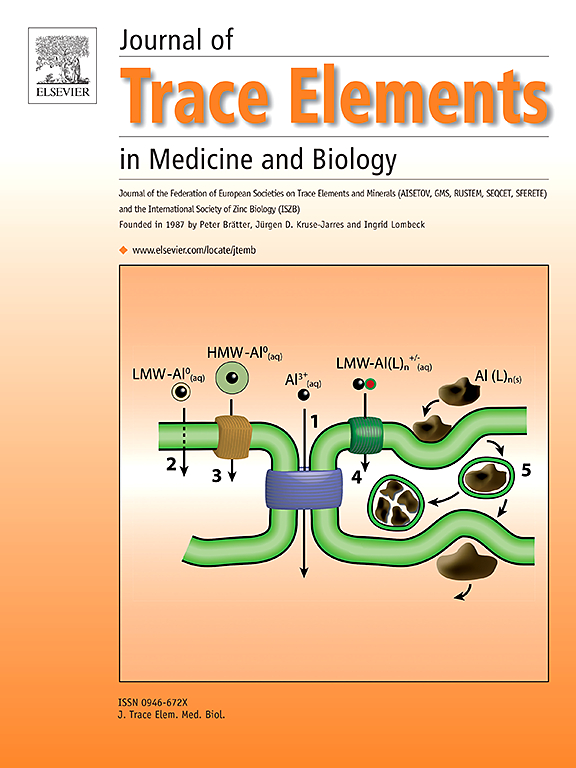Connecting concentrations of copper, selenium, and zinc with transcriptomic and proteomic data of well-characterized human colorectal cancer cell lines
IF 3.6
3区 医学
Q2 BIOCHEMISTRY & MOLECULAR BIOLOGY
Journal of Trace Elements in Medicine and Biology
Pub Date : 2025-03-28
DOI:10.1016/j.jtemb.2025.127638
引用次数: 0
Abstract
Background
Colorectal cancer (CRC) incidence is associated with lower circulating selenium and zinc and elevated copper concentrations. Moreover, copper and selenium accumulate within tumor tissue, indicating a disturbed homeostasis of these essential trace elements in CRC.
Objective
This study aimed to identify associations between CRC characteristics (based on genomic, transcriptomic and proteomic data) and trace element concentrations.
Methods
The concentrations of copper, selenium, and zinc were measured in 83 human CRC cell lines and correlated with transcript and protein expression levels to identify trace element-related gene signatures. By using publicly available gene expression data from The Cancer Genome Atlas we investigated the association between those signatures with the survival probability of CRC patients.
Results
The CRC cell lines differed in their copper (fold change 7.3), selenium (fold change 6), and zinc (fold change 2.6) concentrations. The concentrations were not associated with genetic or cellular characteristics, except for lower copper concentrations in KRAS mutant cells. Expression levels of known copper- and zinc-related proteins correlated significantly with the respective trace element concentrations, serving as a proxy for trace element concentrations in tumors, and with patient survival. This was not the case for selenium and selenoproteins. In addition, an unbiased approach identified novel high and low copper- and zinc-related gene expression signatures significantly associated with patient’s outcome.
Conclusion
Herein we identify gene signatures associated with intracellular copper and zinc concentrations in CRC cell lines. Extrapolating these signatures to primary colorectal tumors revealed that they can inform outcome of CRC patients.
铜、硒和锌的浓度与人类结直肠癌细胞系转录组学和蛋白质组学数据的联系
背景:结直肠癌(CRC)的发病率与低循环硒、锌和高铜浓度有关。此外,铜和硒在肿瘤组织中积累,表明这些必需微量元素在结直肠癌中的稳态受到干扰。目的本研究旨在确定CRC特征(基于基因组、转录组学和蛋白质组学数据)与微量元素浓度之间的关系。方法测定83株人结直肠癌细胞株中铜、硒和锌的浓度,并与转录物和蛋白表达水平进行相关性分析,鉴定微量元素相关基因特征。通过使用癌症基因组图谱中公开可用的基因表达数据,我们研究了这些特征与结直肠癌患者生存概率之间的关系。结果结直肠癌细胞系铜(变化7.3倍)、硒(变化6倍)和锌(变化2.6倍)浓度不同。除了KRAS突变细胞中铜浓度较低外,铜浓度与遗传或细胞特征无关。已知的铜和锌相关蛋白的表达水平与各自的微量元素浓度显著相关,可作为肿瘤中微量元素浓度和患者生存的代理。但硒和硒蛋白却不是这样。此外,一种无偏倚的方法确定了与患者预后显著相关的新的高和低铜和锌相关基因表达特征。结论我们在结直肠癌细胞系中发现了与细胞内铜和锌浓度相关的基因特征。将这些特征外推到原发性结直肠肿瘤表明,它们可以告知结直肠癌患者的预后。
本文章由计算机程序翻译,如有差异,请以英文原文为准。
求助全文
约1分钟内获得全文
求助全文
来源期刊
CiteScore
6.60
自引率
2.90%
发文量
202
审稿时长
85 days
期刊介绍:
The journal provides the reader with a thorough description of theoretical and applied aspects of trace elements in medicine and biology and is devoted to the advancement of scientific knowledge about trace elements and trace element species. Trace elements play essential roles in the maintenance of physiological processes. During the last decades there has been a great deal of scientific investigation about the function and binding of trace elements. The Journal of Trace Elements in Medicine and Biology focuses on the description and dissemination of scientific results concerning the role of trace elements with respect to their mode of action in health and disease and nutritional importance. Progress in the knowledge of the biological role of trace elements depends, however, on advances in trace elements chemistry. Thus the Journal of Trace Elements in Medicine and Biology will include only those papers that base their results on proven analytical methods.
Also, we only publish those articles in which the quality assurance regarding the execution of experiments and achievement of results is guaranteed.

 求助内容:
求助内容: 应助结果提醒方式:
应助结果提醒方式:


